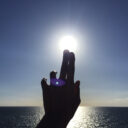Dopo la personale al Glyptothek Museum di Monaco di Baviera, la partecipazione all’ultima Biennale di Venezia, l’esposizione al Pushkin Museum di Mosca, e il più recente progetto “Truly”, che lo vede fino al 4 ottobre in mostra nei luoghi simbolo di Pietrasanta, Fabio Viale è senz’altro tra gli artisti italiani più apprezzati del momento.
In grado di generare straordinari trompe l’oeil in cui il marmo di Carrara, suo materiale prediletto, può prendere le sembianze di una gomma di un’automobile, di una cassetta di legno o di un busto tatuato, Viale sperimenta le leggi della meccanica, della chimica e della fisica, espande la materia, la incide, creando pieni e vuoti, percorsi interni e subliminali, una temporalità allargata e rivestita di nuovi significati.
In molti casi, si tratta di opere di richiamo classico e rinascimentale, dalle Veneri ellenistiche alle dee di Canova, rilette in chiave contemporanea, ma non solo.
L’artista ha affrontato grandi temi di carattere politico, come quello dei migranti, misurandosi con uno tra i più straordinari capolavori scultorei, la Pietà di Michelangelo. Un pilastro visivo della tradizione italiana e più genericamente occidentale. Nella versione di Viale, il Cristo è sottratto al dolore della madre perché sostituito da una figura profana, Lucky Hei, profugo nigeriano che a differenza del Cristo morto, è ancora qui che sopravvive.
AnnaChiara Della Corte: Come riesce ad accostare problematiche attuali ad elementi mitologico-religiosi e figure rinascimentali?
Fabio Viale: “Ci sono simboli universali che hanno delle valenze atemporali. La Pietà ne è la prova. Nutro nei confronti di alcune immagini una sorta di ossessione: la loro riproduzione implica lo studio accurato delle metodologie che poi portano alla loro creazione e realizzazione. Ogni artista arriva alla propria opera come reazione ad un’azione e così come avveniva nel Cinquecento allo stesso modo succede oggi. Immaginando di rappresentare il dolore del Cristo è inevitabile utilizzare come modello l’ultimo, ma anche il primo che i media ci trasmettono come rappresentazione del dolore di una società profondamente ammalata”.
Qual è il significato dei tatuaggi presenti sulle sculture di ispirazione classica? Può indicare come e perché sceglie determinati disegni e colori, e se c’è un rimando socio/politico anche in questo tipo di scelta?
“Nello stereotipo della credenza popolare, il tatuaggio è attribuito ad una forma iconica di tipo criminale che connota negativamente la decorazione corporea e in chiave anticonformista. Probabilmente, chi si tatua avverte la necessità di fare un gesto trasgressivo e quell’operazione applicata alle statue ne amplifica quest’aspetto, perché usurpa il mondo dell’arte e della bellezza classica creduto imperturbabile. Tanto nel passato quanto nel presente esistono immagini che, divenute icone del loro tempo, hanno dato vita ad una simbologia ad esse connessa. Non è in base al Bello, nel senso estetico del termine, che si può giudicare se un’opera passerà alla storia o se verrà guardata in modo indifferente e dimenticata per sempre”.
La 58esima Esposizione Internazionale d’arte, che l’ha vista protagonista al padiglione Italia, aveva un titolo dal rimando quasi apocalittico/profetico “May you live in interesting times”, dove “interesting” assume un significato minaccioso e allo stesso tempo un valore di stimolo, di sfida. Alla luce di quanto accaduto negli ultimi mesi, come interpreta quell’augurio?
“Penso che si stia andando in una direzione dove l’urgenza alberghi su due fronti: da una parte, il sovrappopolamento e dall’altro il cambiamento climatico. La sfida a livello politico sarà quella di riuscire ad accontentare tutti con una risposta democratica; tuttavia la mia visione delle cose non è ottimista, perché sono convinto che la natura dell’uomo abbia aspetti troppo differenti e inconciliabili tra loro. Rispetto agli odierni conflitti razziali, ritengo che sia impossibile chiedere alla gazzella di diventare leone e viceversa. Ognuno di noi nasce con una natura che funziona da predatore o da preda. Purtroppo la radice genera e genererà comportamenti antisociali”.
material illusionism and political engagement
After the personal exhibition at the Glyptothek Museum of Munich, the participation to the last Venice Biennale, the exhibition at the Pushkin Museum of Moscow, and the most recent project, “Truly”, on display until October 4th in the symbolic places of Pietrasanta, Fabio Viale is undoubtedly among the most appreciated Italian artists in the world.
Capable of creating extraordinary trompe-l’oeil where the Carrara marble, his favorite material, can take the shape of a car tire, a wooden crate or a tattooed bust, Viale experiments the laws of mechanics, chemistry and physics, expanding and carving matter, creating full figures and voids, inner subliminal paths, an enlarged temporarily covered with new meanings.
In many cases, they are works with classical and renaissance influences, from the Hellenistic Venuses and the Goddesses by Canova, reinterpreted in a contemporary way, but not only.
The artist has touched contemporary political issues, such as migrations, competing with one of the most extraordinary sculptural masterpieces, Michelangelo’s Pietà. A visual pillar of the Italian and more generally Western tradition. In Viale’s version, the Christ is subtracted from the mother’s pain, because he is replaced with a profane figure, Lucky Hei, a Nigerian refugee who, as opposed to the dead Christ, he is still here surviving.
AnnaChiara Della Corte: How do you manage putting together contemporary issues with mythological-religious elements and Renaissance figures?
Fabio Viale: “There are universal symbols with timeless significance. The Pietà is one of these. I harbor, towards some images, a sort of obsession: their reproduction implies an accurate study of the methodologies that led to their creation and realization. Every artist reaches their piece as a reaction to an action and just as it happened in the sixteenth century, it happens today in the same way. When I envisioned the portrayal of Christ’s pain, I could not avoid using as model the last, but also the first representation of the pain of a deeply sick society, offered by the media”.
What is the meaning of the tattoos on the statues of classical inspiration? Can you tell us how and why you choose specific drawing and colors, or if there is a socio/political reference in this kind of choices as well?
“In the stereotype of popular belief, tattoos are linked to an iconic criminal image, negatively characterizing body decoration in an anti-conformist context. Perhaps, those who love tattoos feel the need to make such a transgressive action, and that action, if applied to statues, amplify this perspective, as it usurps the art world and the classic beauty, once believed to be untouchable. As much in the past as today, there are images that, once turned into icons of their time, have given birth to their own symbology. It is not based on Beauty, in its aesthetic connotation, that you can judge if a piece will go down in history or if it will be seen indifferently and forgotten forever”.
The 58th International Art Expo, to which you took part as protagonist of the Italia Pavilion, had a title with an almost apocalyptic/prophetic reference, “May you live in interesting times”, where “interesting” took a menacing meaning and at the same time a value of incitement, challenge. Considering what has happened in the last few months, how would you interpret this greeting?
“I believe we are taking a direction where the urgency lies on two fronts: on one side, the overpopulation, and on the other, climate change. The challenge, on a political level, will be trying to satisfy everyone with a democratic answer: however, my vision on things is not an optimistic one, because I am conceived that the nature of man has too many different and incompatible aspects. Regarding the current racial conflicts, I believe that you cannot ask a gazelle to become a lion and vice versa. We are all born with a nature functioning as predator or prey. Unfortunately, this root creates and will create antisocial behaviors”.







No Comments